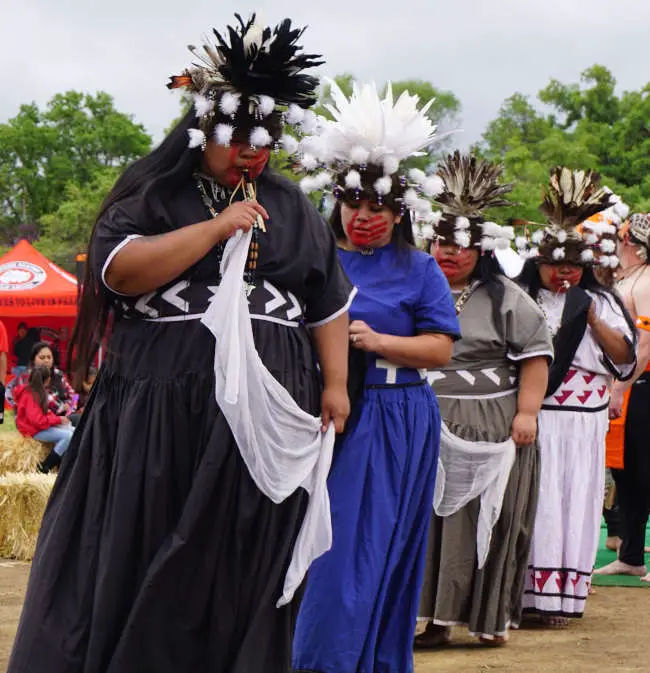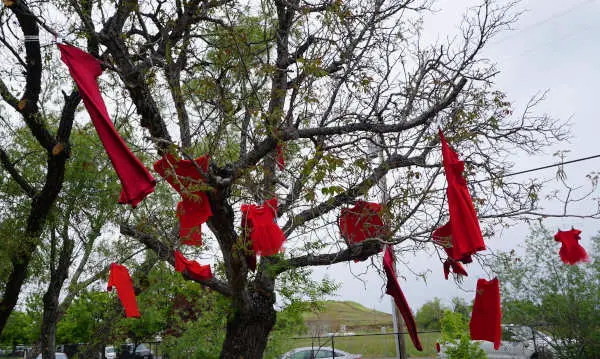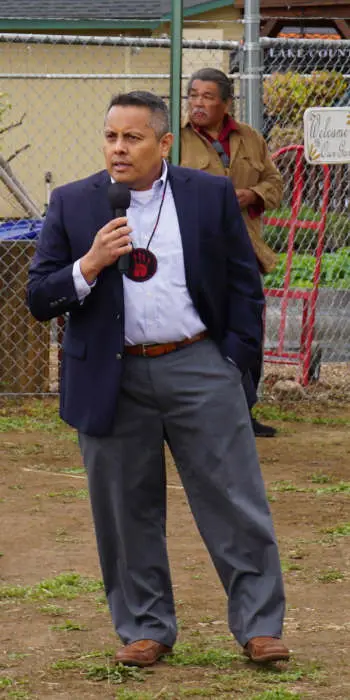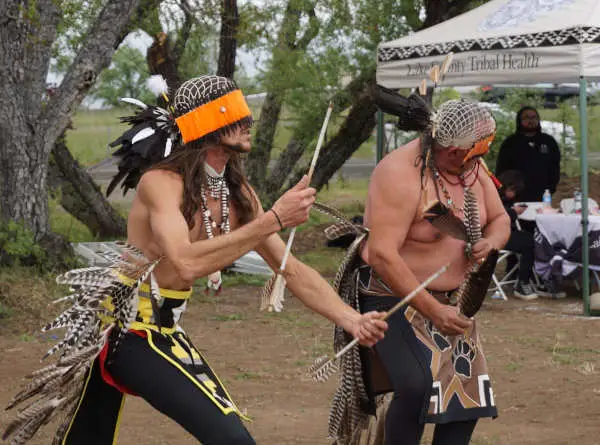
LAKEPORT, Calif. — As rain clouds darkened overhead, a group of Pomo dancers moved in a rhythmic line to a dance circle in Lakeport late Friday afternoon.
The young men and children danced as the feathers in their regalia rustled in the afternoon breeze.
Young women, wearing beaded and feathered headdresses, twirled, their bright dresses swirling around their legs as they played bone whistles.
As the young women raised their heads in the dance, one could see a red palm print across their faces.
That palm print is a symbol of the Missing and Murdered Indigenous People, or Women, variously known as MMIP or MMIW.
Lake County Tribal Health organized the afternoon-long event at 1950 Parallel Drive on Friday, which was National Missing and Murdered Indigenous People’s Day, to put a spotlight on the MMIP crisis, a long-known phenomenon in Indian Country that over the past decade has begun to gain greater nationwide and statewide attention.
Numerous local organizations — from law enforcement to education to health — came to share information. There were games, and a tree was filled with bright red dresses and shirts, also symbolizing the missing.
With centuries of abuse and genocide comes deep and lasting mistrust, which has made it difficult for Indigenous peoples to easily trust law enforcement when reporting their missing loved ones.
The result is that thousands of Indigenous people from across the United States remain missing, their cases unsolved.

The Bureau of Indian Affairs estimates that there are 4,200 missing and murdered cases that remain unsolved nationwide.
“These investigations remain unsolved often due to a lack of investigative resources available to identify new information from witness testimony, re-examine new or retained material evidence, as well as reviewing fresh activities of suspects,” the agency stated on its website.
The solved cases are no less tragic.
In Lake County, the face of MMIP has become Habematolel Pomo tribal member Vanessa Niko.
Niko, 35, a mother of six, was killed on June 30, 2017, beaten fatally by the father of three of her children. A mural of her now graces downtown Upper Lake.
In neighboring Mendocino County, in February 2018, 23-year-old Khadijah Rose Britton was kidnapped at gunpoint in Covelo by her ex-boyfriend.
Britton has not been seen since, and the Federal Bureau of Investigation is offering $10,000 for information leading to the arrest and conviction of those responsible for her disappearance.
In April 2021, Department of the Interior Secretary Deb Haaland created a new Missing and Murdered Unit within the Bureau of Indian Affairs Office of Justice Services to investigate MMIP cases.
In July 2021, President Joe Biden issued a proclamation naming Wednesday, May 5, as Missing and Murdered Indigenous Persons Awareness Day, and said addressing the issues surrounding MMIP is a priority for his administration.
The MMIP situation also has led to action by state lawmakers.
In August, the state Legislature approved AB 1314, a bill by Assemblymember James C. Ramos — the first and only Native American to serve in the Legislature — to establish the “Feather Alert,” a state endangered missing advisory to help law enforcement and tribes locate missing Indigenous people. Gov. Gavin Newsom signed the bill in September.
“The rates of murdered and missing people in Native American communities is a shameful tragedy and does not receive the scrutiny and attention it deserves,” Ramos said in August.

Using technology and science to fight the crisis
At Friday’s event, the keynote speaker was Mark Pooley, a retired police detective whose tribal affiliations are Navajo and Hopi. His heritage is one of the drivers in his fight against the MMIP crisis.
He’s been working to help dozens of families around the United States and in Canada and Italy find their missing loved ones through his investigative skills and use of technology, specifically, DNA. Pooley also credits prayer to the Creator with helping bring breakthroughs.
More than a quarter of those cases have been resolved, either through helping identify human remains or showing people how to successfully find their relatives.
Pooley is director of investigative support for the University of North Texas Center for Human Identification, or UNTCHI, in Fort Worth.
In December, UNTCHI received a nearly $1 million grant through the Missing and Unidentified Human Remains Program from the U.S. Department of Justice’s Bureau of Justice Assistance.
The grant proposal said the university “will implement a comprehensive, multi-disciplinary, multi-agency collaboration to improve the reporting, transportation, processing, and identification of missing person (MP) and unidentified human remains (UHR) cases.”
In addition, UNTCHI intends to offer services to assist small, rural, and/or tribal entities and to support American Indian and Alaska Native communities “which have historically been underserved, and the associated tribal law enforcement agencies that often face unique resource and/or jurisdictional challenges that impede case resolutions.”

Pooley said collecting DNA to help small agencies with solving MMIP cases is a motivation for the three-year grant.
During his talk, Pooley gave five reasons Indigenous people go missing: addiction; domestic violence; runaway children, which he attributes to too many native children living in foster and group homes; human trafficking; and mental illness.
In so many cases, Pooley said it comes down to individuals not understanding how much they are loved.
Pooley offered five priority actions for people to take when a loved one goes missing: make a police report, request police put the missing person into the National Crime Information Center, or NCIC, system; reach out to a local MMIP advocacy group for help getting the word out, including through using social media; start looking in places they frequently go; and use technology in the search.
He’s hopeful that native peoples will get the help and advocacy they need through the growing awareness of the MMIP crisis.
“I’ve never seen the MMIP movement like it is today,” he said.
The dancers came after the speakers, moving slowly to the beat of drummers and singers, spinning, moving around each other in their sacred, steadfast choreography.
Despite the weight of the afternoon event and what it signified, the dance was a reminder that native cultures remain, and that their young people — in the face of the challenges — continue to dance in hope.
Email Elizabeth Larson at This email address is being protected from spambots. You need JavaScript enabled to view it.. Follow her on Twitter, @ERLarson, or Lake County News, @LakeCoNews.


 How to resolve AdBlock issue?
How to resolve AdBlock issue? 





